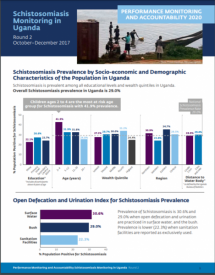Schistosomiasis Monitoring in Uganda, Round 2 October–December 2017
This report offers statistics about the schistosomiasis situation in Uganda, as part of the research for the Bilharzia Communication Campaign which took place there in 2017-2018.
It includes information on:
- Schistosomiasis Prevalence by Socio-economic and Demographic Characteristics of the Population in Uganda
- Open Defecation and Urination Index for Schistosomiasis Prevalence
- Type of Water Contact Activity for Children Ages 2-4 with Contact in Last Month (Caregiver reported)
- Knowledge and Awareness Related to Schistosomiasis
- Schistosomiasis Prevalence if Mass Drug Administration (MDA) Was Reported to have Reached Enumeration Area in Past Two Years
Source: Uganda Ministry of Health, Johns Hopkins Center for Communication Programs, PMA2020
Date of Publication: March 25, 2019
SIMILIAR RESOURCES
Tools
Examples
- Social Behavior Change Programming for Public Health Emergencies: Lessons Learned from the USAID Zika Response in Latin America and the Caribbean
- Strengthening the USAID Zika Response: Experiences from the Zika Social and Behavior Change Working Group
- Zika Virus Global Emergency Response Plan
- Report of the Systematic Review on the Effect of Household Crowding on Health
- Prevention of Sexual Transmission of Zika Virus
- Integrated Management Strategy for Dengue Prevention and Control
- Crisis and Outbreak Communication Pandemic Flu and Other Disasters
- Technical Specifications Content Guide for Behaviors with High Potential to Prevent Zika
- The SBCC Emergency Helix
- Zika Infographics
- Schistosomiasis (“Bilharzia”) Monitoring in Uganda, Round 1 October–December 2016
- Schistosomiasis Prevention Communication Campaign Plan
- Uganda Schistosomiasis Prevention Communication Campaign - Radio Monitoring Plan
- Schistosomiasis Situation in Uganda: A Review of Knowledge, Attitudes and Practices (KAP) associated with Schistosomiasis Infection and Prevention
- A Media Campaign to Prevent Bilharzia in Uganda

